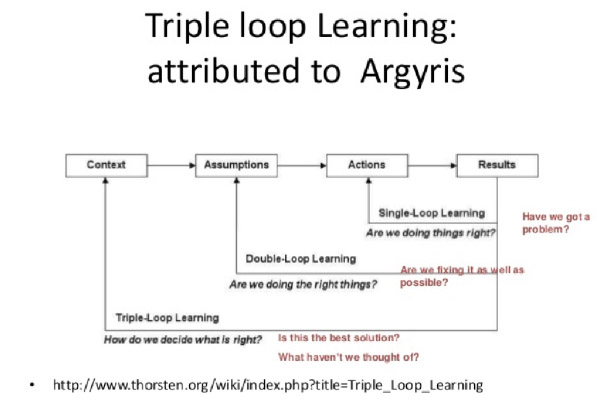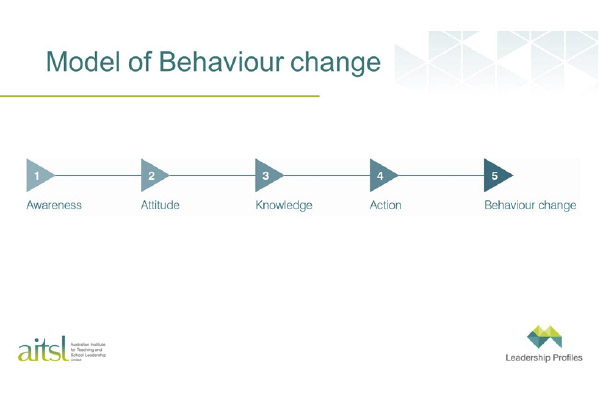Andragogy is the adult equivalent of pedagogy. Both terms have their etymological origins in Ancient Greek and both involve the art of teaching and learning however, pedagogy focuses on the learning of a child while andragogy looks at how adults learn.
Often as adults we have a different driver for the rationale of why we are learning something new compared to a child learner. This results in there needing be be a different way we learn. What works for someone in Kindergarten most likely won’t work for someone in the twentieth year of their career.
A few years ago the team from the Innovation Unit created a video and full report for AITSL on the Global Trends in Professional Learning and Performance Development. The report can be found on AITSL’s website but the video is linked below.
The research conducted by Chris Argyris and his work with the Triple Loop Learning model displays this clearly. As an adult learner, who is learning something for their professional development, we (the learner) want something to change.

In the first Loop of learning we (as the learner) are able to pick up a new behaviour. This might be a new practical skill or a different way to do something. Perhaps it could be changing from taking paper rolls to a digital roll or even learning a new system. In this loop we learn by doing, we can learn something new and purposeful that makes our life easier but in this loop, we are limited overall impact we have on long term behavioural change. Too often school based PL involves the 1st loop only. Here we learn new things but (as Francis Sullivan, the principal who introduced this concept to me says), “We cross our fingers and hope.” We hope that by learning something new staff will have a deep seeded revelation that inspires new pedagogical beliefs and alters behaviour but it just doesn’t often happen that way!
The second Loop of Learning is all about ‘Thinking’. Here we learn new ways of thinking that will impact on our behaviour. We may learn to think and analyse problems differently. This analysis of a problem allows us to select which practical skills best suit a given situation.
The third loop of learning is where we are able to get maximum impact and maximum behavioural change. This is where we grow as a professional. Not just by learning new basic skills, but we learn new beliefs that impact on our thinking and therefore impact on what we do and how we do it.
If you genuinely want to make real change, especially change that is scalable and not just one-off, but inclusive of a whole team, department, or entire school you need to have people involved in the Third Loop of Learning (right from the outset). In this loop people understand the big picture. They have an authentic awareness of what is being changed, how it benefits them and what are the associated benefits to the larger group. This enables adult learners to have the right driver for their professional development.
The AITSL Professional Standards for Principals picks up on this point. In its ‘Model of Behavioural Change’. ‘The Standards’ walk leaders through the process where teachers need to have an awareness of what will be the focus of change and why these changes will be of benefit. Then through a process of strengthening these attitudes and building new learning; staff make changes that they can put into action. And, because there has been a shift in the belief of ‘why’ these changes were needed, the new way of doing things will likely have a long lasting, sustainable, effect. We know that we have achieved a significant behavioural change when the desired outcomes have been measured and the new actions are automatic.

See Page 9 of the Australian Professional Standard for Principals and the Leadership Profiles.
Below is an example of how a school may make a change to have more teachers using contemporary practices within the classroom.
Example: Project Phoenix
‘Inspire – Learn – Reflect’
Initial Inspiration: Teachmeet
Formation of Team Phoenix
Development of clear goals and purpose along with expected deliverables. (T1)
Ongoing learning – Techy Breaky, etc (T1/T2)
Implementation/Action – Altering Teaching programs (T2/T3)
Measuring Impact (T3)
Reporting/Action Research – Peer review (T3/T4)
Publication of learning (sharing success) and impact (inspiration for the next project)
This article first appeared on aussieed.com on the March 11, 2017
Aussieed.com is an online run by some of Australia leading educators in the edtech space.
Brett Salakas is the Founder of #aussieED. He is also a Primary Teacher – 1:1 Educator, Google Certified Teacher, speaker and committed to turning Ed Theory into real classroom practice


Latest posts by etsmagazine (see all)
- Introducing the MOBIUZ Ultrawide Curved Gaming Monitor – The Next Evolution in E-Gaming - January 28, 2022
- Technology For Inclusion With Diverse Learners - December 3, 2019
- 2020 Vision for Interactive Learning in Tomorrow’s Classroom - April 29, 2019
There is 1 comment
Add yoursPost a new comment
You must be logged in to post a comment.


[…] inability to consider complexity at the tactical level via triple loop learning and as a function of strategic orientation is flawed. After all, the strategic private does not […]